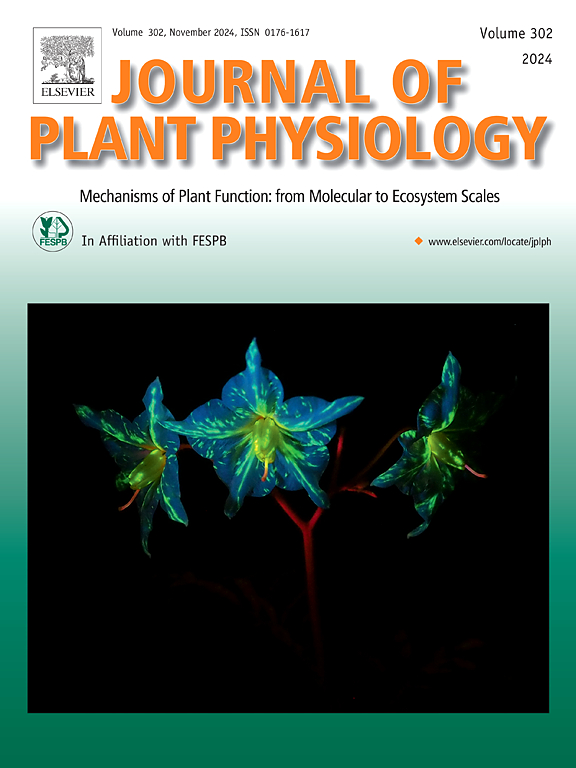Unravelling the gene regulatory network linking red leaf and red flesh traits in teinturier grape
IF 4.1
3区 生物学
Q1 PLANT SCIENCES
引用次数: 0
Abstract
Despite the extensive research conducted on grape anthocyanins, previous studies have predominantly focused on grape skin colour changes, with limited research on flesh colour and leaf colour. In this study, we utilised the superior line 'Zhongshan 151' strain (red flesh and red leaves) as a target and identified that the primary driving force for the transition of leaf colour from green to red was the accumulation of anthocyanins. The study identified a candidate gene, VvMYBA6, and determined that the encoded protein is located in the nucleus and possesses transcriptional activation activity. Subsequent experiments revealed that VvMYBA6 significantly promoted anthocyanin accumulation in tobacco through its overexpression. Further mechanistic investigations elucidated the interaction of VvMYBA6 with the VvMYC1 protein, which activates the expression of VvUFGT, thereby promoting anthocyanin accumulation. Furthermore, an interaction between VvMYBA1 and VvMYC1 was identified in leaves, which is consistent with the mechanism of flesh colour regulation in red-fleshed grapes and affects anthocyanin accumulation by regulating the expression of VvUFGT. The interaction between VvMYBA1 and VvMYBA6 was further verified by yeast two-hybrid (Y2H) and pull-down experiments. This finding indicates that the interaction between VvMYBA6, VvMYBA1 and VvMYC1 plays a pivotal role in the regulation of anthocyanin synthesis, which may significantly impact the development of fruit colour in teinturier grapes.
揭示葡萄红叶和红肉性状的基因调控网络
尽管对葡萄花青素进行了广泛的研究,但以往的研究主要集中在葡萄果皮颜色的变化上,对果肉颜色和叶子颜色的研究有限。本研究以优势品系‘中山151’(红肉红叶)为研究对象,发现花青素的积累是叶片颜色由绿色向红色转变的主要驱动力。该研究确定了一个候选基因,VvMYBA6,并确定编码蛋白位于细胞核中并具有转录激活活性。随后的实验表明,VvMYBA6通过过表达显著促进烟草花青素积累。进一步的机制研究阐明了VvMYBA6与VvMYC1蛋白的相互作用,激活VvUFGT的表达,从而促进花青素的积累。此外,在叶片中发现了VvMYBA1和VvMYC1的互作,这与红肉葡萄果肉颜色的调节机制一致,并通过调节VvUFGT的表达影响花青素的积累。通过酵母双杂交(Y2H)和下拉实验进一步验证了VvMYBA1和VvMYBA6的互作性。这一发现表明,VvMYBA6、VvMYBA1和VvMYC1之间的相互作用在花青素合成的调控中起着关键作用,并可能显著影响teinturier葡萄果实颜色的发育。
本文章由计算机程序翻译,如有差异,请以英文原文为准。
求助全文
约1分钟内获得全文
求助全文
来源期刊

Journal of plant physiology
生物-植物科学
CiteScore
7.20
自引率
4.70%
发文量
196
审稿时长
32 days
期刊介绍:
The Journal of Plant Physiology is a broad-spectrum journal that welcomes high-quality submissions in all major areas of plant physiology, including plant biochemistry, functional biotechnology, computational and synthetic plant biology, growth and development, photosynthesis and respiration, transport and translocation, plant-microbe interactions, biotic and abiotic stress. Studies are welcome at all levels of integration ranging from molecules and cells to organisms and their environments and are expected to use state-of-the-art methodologies. Pure gene expression studies are not within the focus of our journal. To be considered for publication, papers must significantly contribute to the mechanistic understanding of physiological processes, and not be merely descriptive, or confirmatory of previous results. We encourage the submission of papers that explore the physiology of non-model as well as accepted model species and those that bridge basic and applied research. For instance, studies on agricultural plants that show new physiological mechanisms to improve agricultural efficiency are welcome. Studies performed under uncontrolled situations (e.g. field conditions) not providing mechanistic insight will not be considered for publication.
The Journal of Plant Physiology publishes several types of articles: Original Research Articles, Reviews, Perspectives Articles, and Short Communications. Reviews and Perspectives will be solicited by the Editors; unsolicited reviews are also welcome but only from authors with a strong track record in the field of the review. Original research papers comprise the majority of published contributions.
 求助内容:
求助内容: 应助结果提醒方式:
应助结果提醒方式:


